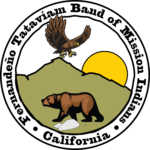This article needs additional citations for verification .(August 2024) |
 The general area where the Tataviam language was spoken prior to European colonization (shown in red) | |
| Regions with significant populations | |
|---|---|
| | |
| Languages | |
| English, Spanish formerly Tataviam | |
| Religion | |
| Traditional tribal religion, Christianity | |
| Related ethnic groups | |
| Tongva, Chumash, Serrano, Kitanemuk, Luiseño, Vanyume |
The Tataviam (Kitanemuk: people on the south slope) are a Native American group in Southern California. The ancestral land of the Tataviam people includes northwest present-day Los Angeles County and southern Ventura County, primarily in the upper basin of the Santa Clara River, the Santa Susana Mountains, and the Sierra Pelona Mountains. They are distinct from the Kitanemuk and the Gabrielino-Tongva peoples. [1]
Contents
- History
- Pre-European settlement
- Spanish colonization
- Mexican governance
- American governance
- See also
- Notes
- Further reading
- External links
Their tribal government is based in San Fernando, California, and includes the Executive Branch, the Legislative Branch, the Tribal Senate, and the Council of Elders. [1] The current Tribal President of the Fernandeño Tataviam Band of Mission Indians is Rudy Ortega Jr., who is a descendant of the village of Tochonanga. [1] [2]
The Tataviam are not federally recognized, which has prevented the tribe from being seen as sovereign and erased the identity of tribal members. [3] [4] The tribe has established an Acknowledge Rent campaign to acknowledge "the financial hardships placed on non-federally recognized tribes." [5] [4]
